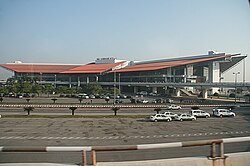Noi Bai International Airport Sân bay quốc tế Nội Bài | |||||||||||||||
|---|---|---|---|---|---|---|---|---|---|---|---|---|---|---|---|
 | |||||||||||||||
 | |||||||||||||||
| Summary | |||||||||||||||
| Airport type | Public / military | ||||||||||||||
| Owner/Operator | Airports Corporation of Vietnam | ||||||||||||||
| Serves | Hanoi Capital Region | ||||||||||||||
| Location | Phú Minh, Sóc Sơn, Hanoi, Vietnam | ||||||||||||||
| Opened | 2 January 1978 | ||||||||||||||
| Hub for | |||||||||||||||
| Operating base for | |||||||||||||||
| Built | 6 August 1964 | ||||||||||||||
| Elevation AMSL | 39 ft / 12 m | ||||||||||||||
| Coordinates | 21°12′50″N 105°48′11″E / 21.21389°N 105.80306°E | ||||||||||||||
| Website | www | ||||||||||||||
| Maps | |||||||||||||||
 | |||||||||||||||
 | |||||||||||||||
| Runways | |||||||||||||||
| |||||||||||||||
| Statistics (2019) | |||||||||||||||
| |||||||||||||||
Source: Taseco Airs[1] | |||||||||||||||
Nội Bài International Airport (IATA: HAN, ICAO: VVNB) in Hanoi, the capital of Vietnam, is the country’s second largest and busiest international airport for passenger traffic, after Tan Son Nhat International Airport in Ho Chi Minh City. It is currently the main airport serving Hanoi, replacing the role of Gia Lam Airport. The airport consists of two passenger terminals and a cargo terminal. Terminal 1 serves domestic flights, and Terminal 2 (inaugurated on 4 January 2015) serves all international flights to and from Hanoi. The airport is currently the main hub of the flag carrier Vietnam Airlines, travel carrier Vietravel Airlines, and an operating base of budget carriers Bamboo Airways and VietJet Air.
The airport is located in Phú Minh commune in Sóc Sơn district, about 35 km (22 mi) northeast of downtown Hanoi, via the new Nhật Tân Bridge (also inaugurated on 4 January 2015).[2] It can also be reached by National Road 3, which connects it with the eastern suburbs of Hanoi. The airport is also close to some satellite cities of Hanoi such as Vĩnh Yên, Bắc Ninh and Thái Nguyên. The airport served a total of 13 million passengers in 2013, despite having a capacity of only 9 million at the time. The new international terminal, which had its first commercial flight on 25 December 2014[3] and went into full operation on 31 December 2014, has boosted the airport's total capacity to 20 million passengers per year. In 2018, the airport served 28 million passengers.[4][5] The airport's IATA code, HAN, is derived from the city's current name of Hanoi.
Of the routes the airport offers, the Hanoi – Ho Chi Minh City route is the busiest flight in Southeast Asia and the fourth busiest in the world, serving 10,883,555 customers in 2023, an increase of 3% in comparison to 2022.[6]
- ^ "TASECO AIRS 2019 BÁO CÁO THƯỜNG NIÊN". Taseco Airs (in Vietnamese). Retrieved 17 January 2020.
- ^ "SGGP English Edition- Noi Bai Airport's Terminal T2, Nhat Tan Bridge inaugurated". Archived from the original on 7 January 2015.
- ^ "News VietNamNet". Archived from the original on 16 February 2016. Retrieved 4 June 2015.
- ^ "Terminal 2 ready to open at Ha Noi airport". Việt Nam News. Archived from the original on 17 December 2014. Retrieved 7 January 2015.
- ^ "Busiest Airport of Vietnam (In Vietnamese)". VNExpress. Retrieved 27 July 2016.
- ^ OAG, OAG (28 February 2024). "Busiest Flight Routes In The World | OAG". OAG.com. Retrieved 28 February 2024.



